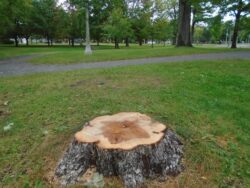Jen Shears loves to hunt.
For the Newfoundland Mi’kmaq woman, hunting was a natural part of life: it clothed, nurtured and bonded her family.
“Growing up, if I didn’t eat wild game, I didn’t eat really, because that’s what sustained us,” she said.
She became an avid outdoorswoman and is raising her daughter the same way. She now owns a store in Newfoundland which sells sealskin products and fishes commercially.

Shears also runs a blog and an Instagram page where she openly posts about her hunts and poses with her catches to encourage sustainable hunting. But occasionally her public stance attracts angry comments from animal activists.
Bears, deer and moose bring the occasional outrage, but none as much as seals.
The anger plays out “from protests outside of our store to mass email and comment campaigns on my social media and blogs.
“I take a lot of pride in wanting to educate people, there are some I feel like I can’t, there’s no way for me to meet them halfway if they’re telling me they’re going to dissolve my 18-month-old daughter and I in acid,” she said.
“The irony is not lost on me that (they’re) doing this in the name of compassion.”
Harvesting seals is controversial in Canada, to say the least. The practice has attracted widespread scrutiny for decades and that has resulted international bans on seal products in 36 countries, notably in Europe and the United States.
The uproar has had an impact on seal hunting. In 2002, 312,000 harp seals were harvested, and in 2016, only 66,800, according to the Department of Fisheries and Oceans (DFO).
But the federal government has recently decided it wants to revive the practice.
In December 2023, DFO published a report that included testimony from dozens of stakeholders and scientists to assess the impact of growing seal populations on ecosystems and commercial fisheries and to determine what to do about the seal hunt.
The harp seal population has grown from an estimated two million seals in 1975 to 7.5 million today, according to the DFO. Many commercial fishers accuse seals of eating up their fish, but the evidence is uncertain.
It’s not the first time that seals have been blamed for eating up all of fishermen’s stock. In 1995, then-Fisheries minister Brian Tobin succeeded in increasing the seal hunt based on the claim that an excessive seal population had caused the cod populations to collapse.
Evidence points more toward decades of overfishing causing the crisis, but seals paid the price for it. The average number of killed harp seals increased by almost 400 per cent between 1996 and 2006 from the 1982 to 1995 average, according to the DFO.
This was met with intense pushback from animal rights groups. Now that the government is, once again, trying to revive seal hunting and the commercial seal market, it is aware of the images and animal rights campaigns that could come.
The very first recommendation to come from the December report asks that the seal harvest “continue to be ethical, humane, sustainable, regionally specific and economically beneficial (...)” with “severe penalties for non-compliance.” Whether the hunt is humane has been the biggest point of contention between pro and anti-sealing activists.
One of the most prominent groups to campaign against the seal hunt in Canada was the International Fund for Animal Welfare.
IFAW was created in 1969 by Brian Davies with the sole purpose of ending Canada’s east coast hunt of whitecoat seals and blueback hooded seals. After observing the hunt, Davies believed it could never be humane. He created the group and campaigned on the slogan “Save the seals.”
Sheryl Fink is their campaign manager for Canada, and before 2013, she had been on the ice every year since she took up her post 20 years ago. She said cruelty to the animals is apparent because of the nature of the hunt, which she likens to a competition.
“All the boats would be out there waiting for DFO to announce the opening of the hunt, once they'd announce the opening, everyone would rush out and start killing the seals as quickly as possible before the quota was reached.”
She said this led to cruelty as people were rushing and not ensuring the seals were deceased before dragging them back to their boats. She also acknowledged the tough conditions on the ice, which made the hunt difficult.
“You're shooting from a moving boat at a moving seal on an ice pan that's kind of bobbing up and down, it's really difficult to get a humane kill,” she said.
She argues that many scientists and veterinarians who’ve studied the hunt have found it inhumane.
Jen Shears says the seal harvest is the most regulated hunt she takes part in, and that a process was put in place by veterinarians to ensure the humane killing of the animals.
“The things that are done in the course of the hunt to ensure it's humane are things that look to be completely inhumane and barbaric,” she said.
Shears is referring to the three-step process enforced by the DFO to ensure seals are humanely killed.
The second step requires hunters to check the skull to ensure both sides are crushed after initially shooting them. If not, they have to hit the seal using a specific tool. Images of this step are often what winds up being shared by organizations such as IFAW and scrutinized by the public.
Before sending scientists and politicians on the ice, IFAW used to send celebrities to drum up more publicity for their cause.
This is what Bill Penney, the chief marketing director for Waspu Oil, a Qalipu First Nation seal oil company, calls “shock and awe marketing.”
Penney says that images of the hunt look bad and generate emotional responses from the public. These tactics have proven to be successful for animal rights groups because seal product companies don’t have the same resources to fight back.
“It takes money to market, and it takes money to get your story out there,” he said.
He said one of the biggest challenges in marketing seal products is countering disinformation about the hunt of whitecoat seals and the status of the seal population.
Whitecoats are newborn harp seals. They have been illegal to hunt since 1987. But some activists say some of the seals being hunted are still very young.
Harp seals, which are the bulk of the hunt, are categorized as a species of least concern. Some ecologists however fear this could change because of climate change.
Penney said that campaigns against the seal hunt misrepresented these issues to get more attention, which has had a lasting effect on the image of the seal hunt and resulted in international bans.
The recent DFO report addressed this concern directly with one of its recommendations, which states that the federal government take steps to re-establish international markets “In light of the economic and cultural harms on Indigenous peoples as a result of misinformation campaigns around pinniped harvesting (...).”
One of the biggest criticisms that animal rights groups such as IFAW, Peeta, and many others have faced following their anti-sealing campaigns was the impact on Indigenous communities.
The sale of seal skin and fur was once a profitable practice for northern Indigenous communities, who had to hunt the seals for food anyway. But when these groups started campaigning against the seal hunt, Indigenous groups saw their profits dwindle
Fink said that IFAW does not oppose the Inuit seal hunt, and PETA agreed in an emailed statement to Capital Current. In the European ban on seals, there are loopholes which allow Indigenous peoples to sell their products.
But Shears said that, despite this acknowledgment, Indigenous peoples have been inadvertently affected by the campaigns.
She said because groups like these portrayed the hunt as barbaric and immoral, the value of seal products decreased in the market, making it unfeasible for Indigenous hunters to make a living selling their product.
She said animal rights groups used images of the hunt, which she acknowledges look bad, as “ammunition” to push for bans in countries. Shears argues that these bans were enacted on moral grounds rather than scientific ones.
Canada isn’t ready to give up on international markets. Another recommendation from the report asks that programs start to market seal products in Canada and internationally.
IFAW doesn’t spend much of its funds on their seal campaign because it has decreased significantly over the years, said Fink, who wishes the government would do the same.
Fink said the government needs to stop putting millions of dollars into the hunt to keep it afloat.
”We do not want to see your taxes being spent on trying to create a seal hunt that we (already) wasted a whole ton of money on,” she said.
“If seal meat tasted good, we’d all be eating it by now. It's not for lack of trying to market seal meat that it's failed.”
Penney and Shears disagree.
Science is on our side, culture is on our side, economy is on our side, sustainability is on our side, yet, people are backing away from (the seal hunt).
Jen Shears, Mi’kmaq businesswoman and hunter
Penney said that seal oil has incredible health benefits and that interest in the product has grown over the years. He said the sales of Waspu Oil have doubled year after year.
He said the seal harvest is as sustainable as it gets when done by Indigenous hunters, who make full use of the body.
“From the meat to the bones, making needles and pins and brooches and buttons, to clothing (....) We promote full utilization, we just know we got to build a market,” he said.
International bans don’t necessarily mean that the world has closed its doors to Canada’s seal products, Penney suggests.
He said he gets between five to ten enquiries every week from United States customers but has to turn them down because of the ban.
Both Penney and Shears say that once people get the full picture of how the seal hunt works, they are much more open to it.
“We have to educate our customers a bit more not just on the benefits of the product, but on the origination,” said Penney.
While animal rights groups see it as a dying industry that the Canadian government needs to stop spending money on, those in the sealing market are hopeful that government and market efforts will help the public see the value in all the products that seals have to offer.
“Science is on our side, culture is on our side, economy is on our side, sustainability is on our side, yet, people are backing away from (the seal hunt),” said Shears.




